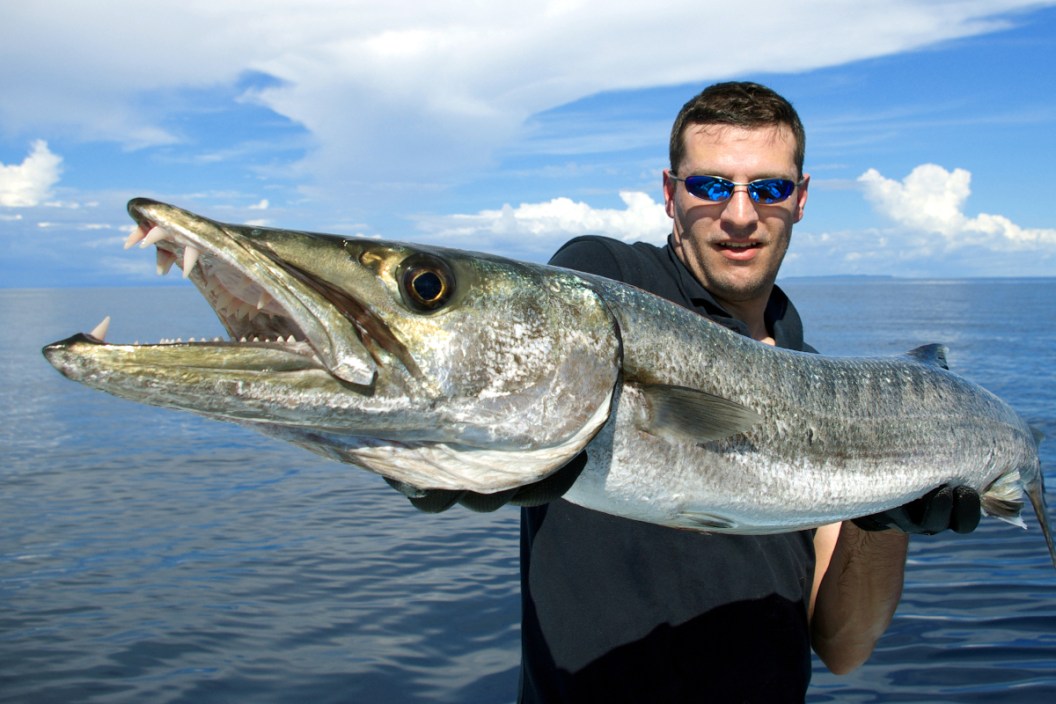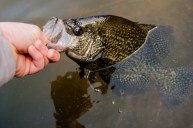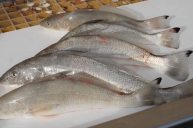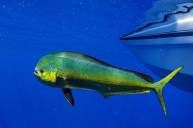Stop wishing, it's time to go barracuda fishing!
The Great Barracuda ranges from foot-long juveniles on shallow flats to aggressive, bruiser-sized fish in the open ocean. They usually max out at around 30 pounds, with the average fish being 5-15 pounds, but some scary 50-pounders are caught offshore each season. They have a great reputation with anglers and fishing charters alike as ferocious fighters.
These fish are marked by a green or grayish color with obvious silvery sides and numerous dark blotches of color, and a tail that is widely forked. Maybe their most obvious trait is in the inside of their unique mouth which is full of long, pointed, razor sharp teeth that must be respected.
As a saltwater sportfish, the Cuda is known as an aggressively striking predatory fish that can and will fight with fast, long runs especially in deeper water. One thing that you will need for sure is some appropriate tackle to take on these spectacular and able fighters.
Barracuda Fishing Tackle
For inshore fishing trips on the flats and along obvious shorelines, spinning and baitcasting tackle work just fine, but don't think that flyfishing gear won't take fish since it is a tried and true method of angling for these toothy monsters.
Medium weight casting gear in the seven-foot range works well with 15 to 20-pound-test braided line, but veterans say that a wire leader is a must. For some, spinning gear in the same ratios work better since there is usually a lot of wind out where you will be seeking fish, and this will keep the backlashes away.
For many applications, simple fluorocarbon works best since barracudas have such good eyesight, but then there's those teeth. It is then a simple matter of using a heavy mono leader (at least for smaller fish) to reduce cutoffs.
Flexible soft plastic lures are known to be deadly on barracudas and many of today's swimbaits fill the bill nicely. Even at that, homemade lures constructed of surgical tube material rigged with a curl in the body so it twists and spins as it is retrieved are cheaper to get and just as deadly.
Sometimes the best action comes on topwater such as chuggers and bombers. The real trick is to figure out what action is turning them on that day. At times, a normal walk-the-dog retrieve works well, while at other times a stickbait with a twitch and stop approach works, while at others a warp-speed cranking of your offering has them coming out of the water for it.
Key Areas To Target
Many veteran barracuda anglers will tell you that they are good to target in the shallows when other fish (as we well know) disappear- after a cold front moves through. Other preferred species such as tarpon and bonefish will head to deeper water during these conditions where as Cuda will head in to feed and warm up on the incoming tide.
Now is the time for some of the best sight fishing there is. This is where a solid fishing guide will be the difference between seeing fish and catching them since they know what to look for and can guide the angler to his or her acting target area in front of a spotted fish.
Even in water conditions where fish are hard to spot, blind casting is still something that any fisherman can do. However, for these easy to spook skinny water fish, it's time for the more finesse style of bait like the soft plastic tube. You may miss fish that you never knew were there due to their wariness, but that happens with any type of fishing.
Deep sea fishing the reefs and wrecks of an area is where anglers will find packs of barracuda and most often where the largest fish tend to congregate.
Barracuda Fishing Tips
Anglers the world over head to places like the Bahamas, the Yucatan, and Belize. These places offer some of the best fishing for everything from bonefish, tarpon, and permit to escape the clutches of life and hook up with some of the greatest fishing there is to have. Maybe the best part is that by doing so, they will have some spectacular by catches of the sphyraena barracuda, or the Great Barracuda.
The thing is this- once an angler has hooked up with one of these monstrous fighters, it may have them wondering aloud why they weren't fishing for them in the first place!
For our purposes we'll look at one of the greatest places on earth to catch one, while spending your hard-earned money right here in the contiguous US: the Florida Keys. Game fish like these prowl the inshore shallow water so commonly that they've become a favorite with some since they are so aggressive, and when it comes to having some amazing sportfishing we always like to say "yes please"
Coral reefs, light tackle, and live bait are some of the keys to trying some flats fishing. In fact, anything that resembles the needle fish or ballyhoo such as virtually any Rapala lure will garner some tooth-rattling strikes.
Cudas in the 30-pound range are sometimes taken on 8-pound spinning tackle (with a heavier wire leader) and a tube lure by guided anglers walking the flats or from the deck of a skiff by sight fishing or blind casting with a good pair of polarized sunglasses.
Casting for spotted fish should always be done 10-feet past the fish and in front of it so as not to spook these wary game fish. Retrieves should emphasize speed, since fleeing triggers the pursuit and attack aggression in barracuda, but sometimes it is stealth that wins the day since shallow water fish are so wary.
Having a good guide service at your disposal is the key to any good fishing techniques that you may need, and they will also clue you in on the best tackle for the conditions present. Plus, having an extra set of veteran eyes on the water with you will only give an angler an added edge when it comes spotting, hooking, and releasing a Cuda to fight another day.
Products featured on Wide Open Spaces are independently selected by our editors. However, when you buy something through our links, we may earn a commission.
Looking for a little more or even hot lunch for your hunting blind? Follow my webpage, or on Facebook and YouTube.
NEXT: 6 WAYS TO CATCH A BROWN TROUT
WATCH





